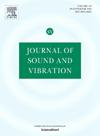适应一组初始条件的最佳阻尼
IF 4.3
2区 工程技术
Q1 ACOUSTICS
引用次数: 0
摘要
振动系统可以对无限多个初始条件作出响应,并且系统的整体动力学会受到这些初始条件的强烈影响。因此,找到一种方法,使我们能够确定在某种意义上对所有初始条件或给定一组初始条件都是最优的阻尼,这是非常重要的。对于单自由度和多自由度系统,我们使用最小化系统能量的时间积分(从0到无穷)的已知方法确定适合于不同初始条件集的最佳阻尼系数,在一组初始条件上平均,并使用我们引入的两种新方法。一种方法是基于确定阻尼,在一组初始条件下,系统的能量平均下降到给定阈值的速度最快。另一种方法是基于确定给出最小系统平均沉降时间的阻尼,其中我们认为当其能量下降到给定阈值时系统沉降。我们发现,这两种新方法给出的最优阻尼结果彼此非常一致,但与平均能量积分最小化所给出的结果有很大不同。更准确地说,对于考虑的多自由度系统和初始条件集,两种新方法给出了最优阻尼系数,随着目标能量阈值的降低,该系数收敛于第一模态的临界阻尼。另一方面,对于这些相同的系统和初始条件集,最小化平均能量积分的方法给出了相对于第一模态处于过阻尼状态的最优阻尼系数。本文章由计算机程序翻译,如有差异,请以英文原文为准。
Optimal damping adapted to a set of initial conditions
Vibrating systems can respond to an infinite number of initial conditions and the overall dynamics of the system can be strongly affected by them. Therefore, it is of practical importance to have methods by which we can determine the damping that is in some sense optimal for all initial conditions, or for a given set of initial conditions. For a single and multi degree of freedom systems, we determine the optimal damping coefficients adapted to different sets of initial conditions using the known method of minimizing the (zero to infinity) time integral of the energy of the system, averaged over a set of initial conditions, and using two new methods that we introduce. One method is based on determining the damping for which the energy of the system, averaged over a set of initial conditions, drops the fastest to a given threshold value. The other method is based on determining the damping that gives minimal average settling time of the system, where we take that the system settled when its energy dropped to a given threshold value. We show that the two new methods give results for optimal damping that are in excellent agreement with each other, but are significantly different from the results given by the minimization of the average energy integral. More precisely, for considered multi degree of freedom systems and sets of initial conditions, the two new methods give optimal damping coefficients that converge to the critical damping of the first mode as the target energy threshold decreases. On the other hand, for these same systems and sets of initial conditions, the method of minimizing the average energy integral gives optimal damping coefficients which are deep in the overdamped regime with respect to the first mode.
求助全文
通过发布文献求助,成功后即可免费获取论文全文。
去求助
来源期刊

Journal of Sound and Vibration
工程技术-工程:机械
CiteScore
9.10
自引率
10.60%
发文量
551
审稿时长
69 days
期刊介绍:
The Journal of Sound and Vibration (JSV) is an independent journal devoted to the prompt publication of original papers, both theoretical and experimental, that provide new information on any aspect of sound or vibration. There is an emphasis on fundamental work that has potential for practical application.
JSV was founded and operates on the premise that the subject of sound and vibration requires a journal that publishes papers of a high technical standard across the various subdisciplines, thus facilitating awareness of techniques and discoveries in one area that may be applicable in others.
 求助内容:
求助内容: 应助结果提醒方式:
应助结果提醒方式:


